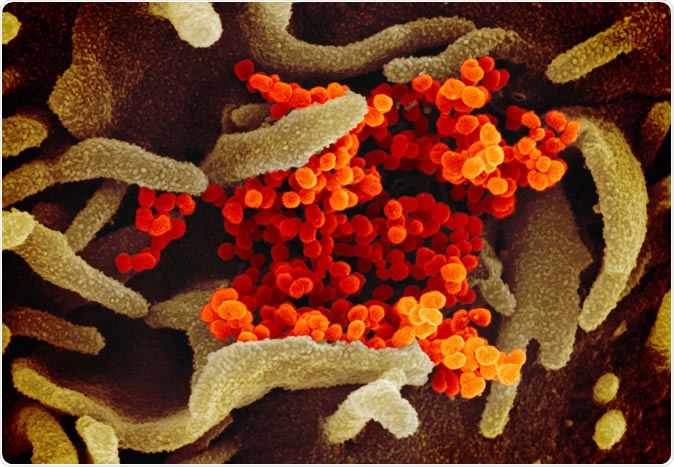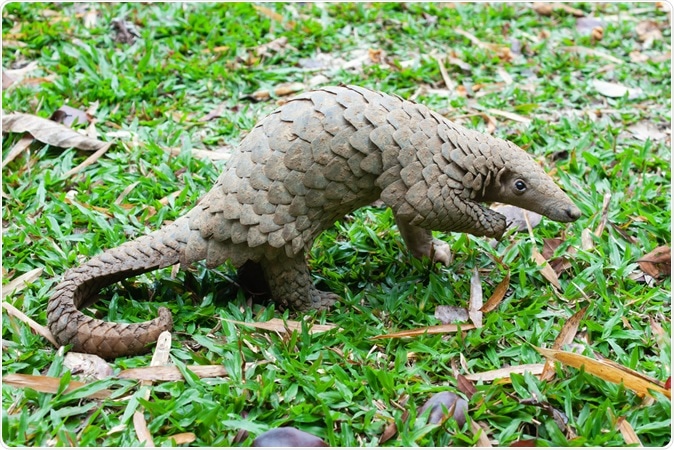With over 780,000 individuals across the world infected and over 37,000 dead, the world is gripped by the pandemic caused by the novel strain of coronavirus, severe acute respiratory syndrome coronavirus 2 (SARS-CoV-2).
In new research, a team of virologists has looked into the origins of the novel coronavirus that leads to COVID-19 disease. Their study titled “The proximal origin of SARS-CoV-2” is published in the journal Nature Medicine.

Novel Coronavirus SARS-CoV-2 This scanning electron microscope image shows SARS-CoV-2 (orange)—also known as 2019-nCoV, the virus that causes COVID-19—isolated from a patient in the U.S., emerging from the surface of cells (green) cultured in the lab. Credit: NIAID-RML
What was this study about?
The international team of researchers from the United States, Australia, and Britain has sifted through medical data from researchers around the world to find answers. This study was a joint effort from Kristian Andersen from the Scripps Research Institute in California, Ian Lipkin from Columbia University in New York, Robert Garry from Tulane University in New Orleans, and Andrew Rambaut from the University of Edinburgh in Scotland and Edward Holmes from the University of Sydney.
Initially, in late 2019, unexplained pneumonia was observed in patients in the Chinese city of Wuhan in Hubei province. Investigators had traced back some of the infections to the wild exotic animal markets of Wuhan. A substantial number of samples from the market had tested positive for the virus. Animal to human transmission was speculated at the time.
The team writes, “SARS-CoV-2 is the seventh coronavirus known to infect humans; SARS-CoV, MERS-CoV, and SARS-CoV-2 can cause severe disease, whereas HKU1, NL63, OC43, and 229E are associated with mild symptoms.”
The researchers propose two ways in which the virus could have progressed:
“(i) natural selection in an animal host before zoonotic transfer; and
(ii) natural selection in humans following a zoonotic transfer.”
Progression of the virus – Step 1 animal to human transmission
Virologists from the Wuhan Institute of Virology with Shi Zhengli at its head noted that a bat virus called betacoronavirus, found near the China-Myanmar border in a mountain cave had over 96 percent similarity with the novel coronavirus causing COVID-19. What was dissimilar was that the bat virus did not have spike proteins on its surface that could help it to attack human cells. The virologists went on to look for the origins of the virus in other animals. They soon found the Malayan pangolins (Manis javanica) were infected by a virus that contained similar spike protein. This was found by two different teams from Guangzhou and Hong Kong. It was then speculated that there had been recombination of the genomic make-up of the bat and pangolin viruses, they wrote.

Java Pangolin (Manis javanica) smuggled in Asia and popularly consumed as scales are an ingredient in Chinese medicine. Wildlife crime. Image Credit: Binturong-tonoscarpe / Shutterstock
The researchers then found that the virus had the potential to mutate, and this mutation made animal hosts immune to it. As the infection repeatedly occurred in humans, the mutations became more prominent, they wrote.
Expert speak
In a statement from Dr. Francis Collins, director of the US National Institute of Health, it became clear that animal to human transmission was soon replaced by the human to human transmission. He said, “Then, as a result of gradual evolutionary changes over the years or perhaps decades, the virus eventually gained the ability to spread from human to human and cause serious, often life-threatening disease.”
Progression of the virus – Step 2 - changes within the humans due to mutations
As human to human to transmission became more evident, with more and more people becoming infected, and severe acute respiratory syndrome common in each case, the virus was named SARS-CoV-2 after its predecessors SARS and MERS infections before.
This new virus was now found to have a mutation in its genes, called a “polybasic cleavage site.” This wasn’t seen in either bat, and pangolin viruses explained Anderson.
The team said that their study reiterated what had already been found by scientists from China, United States, and France. They wrote that the spike protein on the virus interacts with furin, which an enzyme found abundantly in the body. Furin assisted the virus envelope in merging with the cell membrane to infect it. Similar furin-like sites were also found in other viruses such as HIV and Ebola. The team wrote that this mutation allowed the virus to skip animal to human transmission and allow it to infect humans.
They also found that the coronaviruses causing SARS and MERS earlier were also descended from coronaviruses affecting masked civets and camels. Their genetic similarity was found to be 99 percent. This level of similarity was not found between bat and pangolin viruses and SARS-CoV-2, they wrote.
They wrote, “It is possible that a progenitor of SARS-CoV-2 jumped into humans, acquiring the genomic features described above through adaptation during undetected human-to-human transmission… Once acquired, these adaptations would enable the pandemic to take off and produce a sufficiently large cluster of cases to trigger the surveillance system that detected it.”
Was this a man-made virus?
The team wrote that SARS-CoV had been studied in research labs for a while now in cell cultures and animal models in biosafety level 2 labs around the globe. There have been reported evidence of the inadvertent release of the SARS-CoV, they wrote. To exclude that this was a similar episode, they looked at it more in-depth. Their research revealed that the mutations of the SARS-CoV-2, as we see now is not possible without “cell culture or animals with ACE2 receptors similar to those of humans”. Specifically, there were “polybasic cleavage site and predicted O-linked glycans,” they explained. Neither of these is possible with cell cultures, they wrote.
Conclusions and future directions
Despite the speculations, the team firmly believes, “We offer a perspective on the notable features of the SARS-CoV-2 genome and discuss scenarios by which they could have arisen. Our analyses clearly show that SARS-CoV-2 is not a laboratory construct or a purposefully manipulated virus.”
They also speculate that the closely related animal viruses can help in research with SARS-CoV-2. Meanwhile, they explain that studies are on to look for the missing links between the animal viruses and the present human virus. They sign off, “Irrespective of the exact mechanisms by which SARS-CoV-2 originated via natural selection, the ongoing surveillance of pneumonia in humans and other animals is clearly of utmost importance.”
Journal reference:
Andersen, K.G., Rambaut, A., Lipkin, W.I. et al. The proximal origin of SARS-CoV-2. Nat Med (2020). https://doi.org/10.1038/s41591-020-0820-9